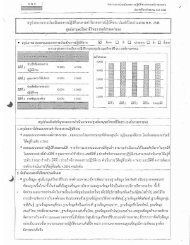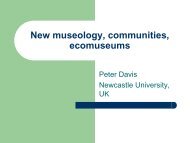Download
Download
Download
Create successful ePaper yourself
Turn your PDF publications into a flip-book with our unique Google optimized e-Paper software.
An ethnic Khmer native of Surin province andlanguage rights activist, Mr. Chaimongkol has travelledextensively around Thailand, and even across theborder to Cambodia in his efforts to safeguard the localKhmer heritage and language. In addition to bringingtogether the old masters to play traditional music,Chaimongkol was also involved in the digitization ofKhmer Buddhist scriptures and the organization ofKhmer language lessons at local monasteries for bothadults and children. He had turned his home on theoutskirts of Surin into a centre for the preservationand propagation of the local Khmer culture. He haddevoted his own time and resources to these activitiesand it was impossible to be in his proximity withoutfeeling the same commitment, concern and affectionfor the local heritage. Dr. Vail had also done a greatdeal of research in the area and knew many of thelocal musicians and culture bearers. He spoke fluentThai and some Khmer, which proved extremely helpfulduring the production and editing of the film. Hisinsights, natural curiosity and great rapport with thelocal people complemented Chaimongkol’s devotionand connectedness to the local community. Togetherwe devised a tentative spine for the documentary thatdetermined how it would unfold.10Local masters playing together at Ta Lon’s houseThe film, entitled “Grabbing the Blue Tiger:The Past and Future of Northern Musical Khmer Arts,”explores the challenges in safeguarding the local Khmerlanguage and heritage using kantreum as a point ofentry. Through interviews with several generations ofkantreum performers and local heritage advocates andexperts, the film documents the myriad social, economicand cultural forces which have led to the gradual declineof the traditional form of kantreum, known as kantreumdangdeum. Once performed primarily for healing andspirit mediumship rites called col maemot, kantreumdangdeum was now increasingly being performed only forcultural heritage events, while the more popular, electronicgenre, called kantreum prayuk, could be found widely onlocal stages and in CD stores in Surin, and as far afieldas Cambodia.Another core message of the film had to do withthe centrality of Khmer language to the transmission ofkantreum dangdeum. Without the revitalization of Khmerlanguage skills among the younger generations of ethnicKhmer, there was little chance that this genre would existin the near future.Ta Lon singing kantreum at a Maemot(spirit mediumship) ceremonyReflecting on the collaborative filmmakingprocess, for me, the language was the greatest barrier,and both Peter and Chaimongkol tried their hardest to fillme in whenever possible. During interviews, sometimesI generally understood what was being said, but othertimes I was totally in the dark. We would film part of aninterview, pause to have a brief discussion, and thendetermine how to proceed, deciding how to adapt ouroriginal plan. By the time the film was finally edited, I knewmost of the interviews almost word-by-word. Anotherchallenge of the filmmaking process was that our planswere frequently disrupted by the spontaneous changesthat were made in the filming schedule. Even so, I feltvery respected and included in all aspects of the projectand I am greatly thankful for that.One of the oft-cited risks of filmmaking in anunfamiliar culture is the tendency to exotify the “Other.”This risk becomes greater with visual media, whichcan be very powerful and convincing. The filmmaker’s







